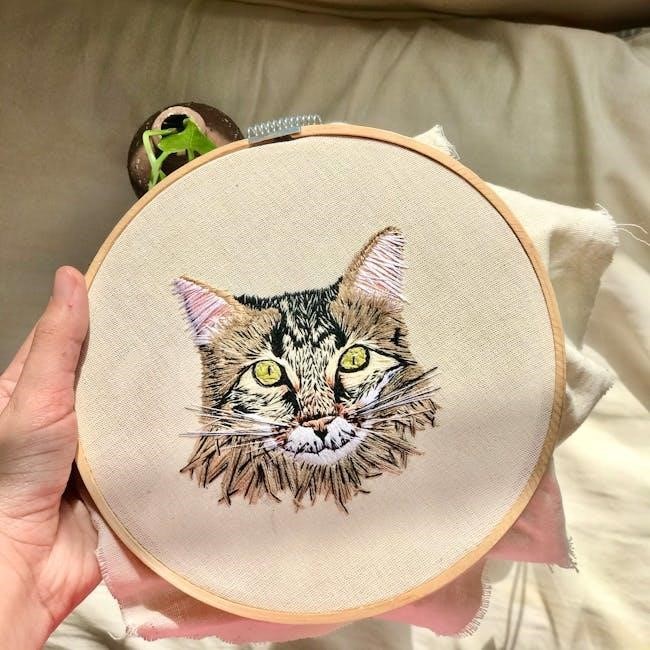IPC WHMA A 620 is a global standard for cable and wire harness assemblies, ensuring quality and reliability in manufacturing. Developed by IPC and WHMA, it provides criteria for materials, processes, and verification, serving as a critical reference for manufacturers and inspectors worldwide.
1.1 What is IPC WHMA A 620?
IPC WHMA A 620 is a widely recognized standard for the manufacture and acceptance of cable and wire harness assemblies. Published by IPC and the Wire Harness Manufacturers Association (WHMA), it provides detailed criteria for materials, workmanship, and inspection. The standard ensures consistency and quality in the production of wire harnesses and cables, addressing aspects such as soldering, crimping, and wiring. It serves as a critical guide for manufacturers, inspectors, and quality personnel across industries like aerospace, automotive, and industrial electronics, promoting reliability and compliance in electronic systems.
1.2 Importance of IPC WHMA A 620 in Cable and Wire Harness Assemblies
IPC WHMA A 620 is essential for ensuring the quality and reliability of cable and wire harness assemblies. It establishes standardized criteria for materials, processes, and inspections, reducing variability and defects. By following this standard, manufacturers can meet customer and industry expectations, ensuring compliance with global quality requirements. Its guidelines promote consistency, traceability, and reliability, making it indispensable for industries requiring high-performance and durable electrical systems. Adherence to IPC WHMA A 620 enhances product quality, reduces warranty claims, and builds customer trust, making it a cornerstone of modern wire harness manufacturing.

Scope and Purpose of the Standard
IPC WHMA A 620 defines requirements for cable and wire harness assemblies, ensuring quality, consistency, and reliability. It provides comprehensive guidelines for materials, processes, and verification to meet industry standards and customer expectations, fostering trust and excellence in manufacturing.
2.1 Key Objectives of IPC WHMA A 620
The primary objectives of IPC WHMA A 620 are to establish standardized criteria for the manufacture, inspection, and testing of cable and wire harness assemblies. It aims to ensure product reliability, consistency, and quality by providing clear acceptability guidelines for materials and processes. The standard also focuses on reducing variability, improving manufacturing efficiency, and ensuring compliance with industry best practices. By addressing these key areas, IPC WHMA A 620 helps manufacturers meet customer expectations and maintain high levels of performance in their products;
2.2 Industries That Benefit from IPC WHMA A 620
IPC WHMA A 620 benefits industries requiring high-quality cable and wire harness assemblies, such as aerospace, automotive, telecommunications, and industrial equipment manufacturing. The standard ensures compliance with strict quality benchmarks, reducing defects and enhancing reliability. It is particularly valuable for industries where failure of wire harnesses could lead to safety risks or operational downtime. By adhering to IPC WHMA A 620, manufacturers across these sectors can maintain consistency, improve efficiency, and meet customer expectations for durable and performance-critical products.

Key Changes in Different Revisions
IPC WHMA A 620 revisions include updates to technical requirements, improved usability, and alignment with industry standards, ensuring enhanced quality and reliability in cable and wire harness assemblies.
3.1 IPC/WHMA-A-620 (January 2002)
The initial release of IPC/WHMA-A-620 in January 2002 established foundational requirements for cable and wire harness assemblies. It introduced visual, electrical, and mechanical acceptance criteria, setting a benchmark for quality and reliability in manufacturing. This revision focused on standardizing processes and materials, providing clear guidelines for inspectors and manufacturers. The document emphasized defect prevention and process control, ensuring consistent production quality across industries. It also included detailed illustrations and charts to aid in understanding and implementation. This version laid the groundwork for future updates, addressing the evolving needs of the electronics industry;
3.2 IPC/WHMA-A-620A (July 2006)
Released in July 2006, IPC/WHMA-A-620A introduced significant updates to the standard, enhancing clarity and adding new criteria for wire harness assemblies. This revision focused on improving visual inspection standards, including color coding and labeling requirements. It also addressed mechanical testing procedures, ensuring better durability and reliability in cable assemblies. The update reflected industry feedback, incorporating advancements in materials and manufacturing techniques. These changes aimed to align the standard with emerging technologies while maintaining its core focus on quality and consistency in production processes.
3.3 IPC/WHMA-A-620B (October 2012)
The October 2012 revision, IPC/WHMA-A-620B, introduced comprehensive updates to the standard, focusing on technical improvements and enhanced usability. Key changes included expanded criteria for shielding, crimping, and wiring, as well as updated test methods for ensuring compliance. The revision also addressed compatibility with other IPC standards, streamlining integration into manufacturing workflows. Additionally, it incorporated feedback from industry professionals, refining acceptance criteria for wire harness assemblies. These updates aimed to improve product reliability and adapt to evolving technologies in the cable and wire harness manufacturing sector.
3.4 IPC/WHMA-A-620E (October 2022)
Released in October 2022, the IPC/WHMA-A-620E revision represents a significant update to the standard, incorporating advancements in technology and industry feedback. This revision introduces enhanced criteria for cable and wire harness assemblies, with a focus on improving clarity and usability. Key updates include new sections on automation, sustainability, and updated acceptance criteria for modern materials and manufacturing processes. The E revision also aligns with other IPC standards, ensuring compatibility and ease of implementation across the industry.

Visual and Mechanical Requirements
IPC WHMA A 620 establishes visual and mechanical criteria for cable and wire harness assemblies, ensuring proper appearance, secure connections, and structural integrity for reliable performance.
4.1 Cable and Wire Harness Assembly Criteria
IPC WHMA A 620 provides detailed criteria for cable and wire harness assemblies, including wire preparation, soldering, crimping, and harness protection. It ensures consistent quality through visual and mechanical standards, covering aspects like insulation, shielding, and labeling. The document specifies acceptable and non-conforming conditions, serving as a comprehensive guide for manufacturers to achieve reliable and durable assemblies. Compliance with these criteria enhances product performance and customer satisfaction across various industries.
4.2 Acceptance Standards for Electrical and Mechanical Properties
IPC WHMA A 620 establishes acceptance standards for electrical and mechanical properties of cable and wire harness assemblies. It specifies requirements for conductivity, insulation resistance, and pull force testing to ensure reliability. The standard outlines acceptable tolerances for wire stripping, crimping, and soldering, ensuring minimal defects. Mechanical properties, such as flexural endurance and tensile strength, are also addressed to guarantee durability. Compliance with these standards ensures assemblies meet performance and safety expectations, reducing the risk of electrical or mechanical failures in final products.

Inspection and Testing Procedures
IPC WHMA A 620 outlines detailed inspection and testing procedures to ensure cable and wire harness assemblies meet specified quality standards. These procedures include visual inspections, electrical continuity tests, and mechanical integrity checks to verify compliance with acceptance criteria. The standard emphasizes thorough verification of all assembly aspects to maintain product reliability and performance.
5.1 Quality Control Processes in Wire Harness Manufacturing
IPC WHMA A 620 establishes robust quality control processes to ensure wire harness manufacturing meets stringent standards. It outlines systematic inspections, testing, and documentation procedures to verify compliance with specified criteria. Manufacturers must conduct regular checks at each production stage, from material selection to final assembly, to identify and address defects early. The standard emphasizes adherence to visual, mechanical, and electrical acceptance criteria, ensuring consistency and reliability. Proper documentation and traceability are also required to maintain accountability and facilitate continuous improvement in production processes.
Training and Certification Programs
IPC WHMA A 620 offers training programs enabling professionals to gain expertise in cable and wire harness assembly standards, ensuring consistency and adherence to industry standards.
6.1 IPC-Approved Training for Wire Harness Assembly
IPC-approved training programs for wire harness assembly ensure professionals master the standards outlined in IPC WHMA A 620. These programs are designed for manufacturers, inspectors, and engineers, focusing on visual, electrical, and mechanical acceptance criteria. They cover materials, processes, and verification methods, emphasizing consistency and quality. Training includes hands-on exercises and theoretical knowledge, preparing participants for certification. IPC also offers video courses, such as one highlighting changes between revisions, to enhance understanding and compliance with the latest standards. This structured approach ensures adherence to industry best practices, improving product reliability and assembly efficiency.

Benefits of Compliance
Compliance with IPC WHMA A 620 ensures enhanced product reliability, reduced defects, and consistency in cable and wire harness assemblies. It aligns with industry standards, improving performance and customer satisfaction.
7.1 How Compliance Enhances Product Reliability
Compliance with IPC WHMA A 620 ensures enhanced product reliability by providing clear criteria for materials, processes, and verification. It reduces defects and ensures consistency in cable and wire harness assemblies. The standard’s detailed acceptance criteria for electrical, mechanical, and visual properties minimize failures. By adhering to these guidelines, manufacturers can produce high-quality assemblies that meet customer expectations and industry standards. This leads to improved performance, durability, and safety, ultimately boosting customer satisfaction and brand reputation in the global market.

Future Trends and Updates
The IPC WHMA A 620 standard continues to evolve, incorporating emerging technologies and updates to address industry advancements. The latest revision, IPC/WHMA-A-620E, reflects these changes, ensuring alignment with modern manufacturing practices.
8.1 Emerging Technologies in Cable and Wire Harness Manufacturing
Emerging technologies are reshaping cable and wire harness manufacturing, with advancements in automation, IoT, and smart manufacturing. Robotics and AI optimize production, improving precision and efficiency. High-speed data transmission demands advanced materials and connectors. Additive manufacturing enables complex geometries and custom solutions. Sustainability initiatives drive the use of eco-friendly materials. These innovations align with IPC WHMA A 620 standards, ensuring compliance and reliability in next-gen applications. The integration of these technologies promises enhanced performance, reduced costs, and greener practices, keeping the industry at the forefront of technological evolution.

How to Obtain the IPC WHMA A 620 Document
The IPC WHMA A 620 document can be purchased directly from IPC or WHMA official websites, ensuring access to the latest revision for compliance and manufacturing needs.
9.1 Sources for Downloading the Latest Revision
The latest revision of the IPC WHMA A 620 document can be downloaded from the official IPC and WHMA websites. Additionally, it is available through authorized distributors like IHS Markit, Techstreet, and ANSI. These platforms provide secure and reliable access to the standard in PDF format, ensuring compliance with the most recent updates and requirements. Purchasing from these official sources guarantees authenticity and access to the latest revision, which is essential for staying compliant with industry standards.
IPC WHMA A 620 is a cornerstone standard for cable and wire harness manufacturing, ensuring quality, reliability, and consistency. Its comprehensive guidelines have become indispensable for manufacturers worldwide, reducing errors and enhancing efficiency. By adhering to IPC WHMA A 620, companies ensure compliance with industry best practices, fostering trust and confidence in their products. Regular updates reflect evolving technologies, making it essential to adopt the latest revisions. This standard remains a vital tool for achieving excellence in wire harness assembly, driving innovation, and meeting global market demands.

References
- IPC-610: Acceptability of Electronic Assemblies.
- IPC/WHMA-A-620E: Requirements and Acceptance for Cable and Wire Harness Assemblies.
- IPC-HDBK-620: Handbook for Cable and Wire Harness Assemblies.
- IPC-DRM-WHA-C: Dimensioning and Tolerancing for Wire Harness Assemblies.
- IPC-TR-6010: IPC Technical Report for Cable and Wire Harness.















































































